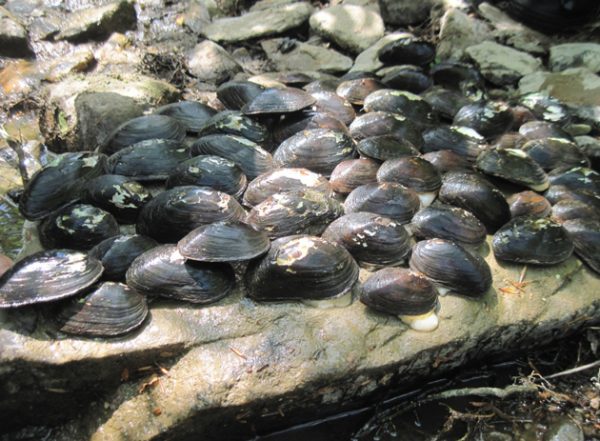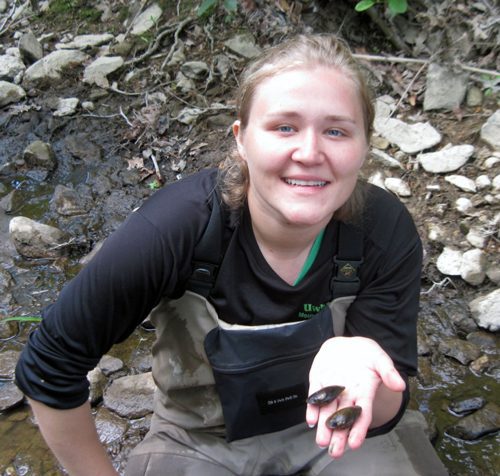Freshwater mussels: tiny hitchhikers

Recently, I participated in a survey of mussels as part of a post-dam removal monitoring effort at the Densons Creek Nature Preserve in Troy (60 miles east of Charlotte). I joined folks from the U.S. Fish and Wildlife Service and the N.C. Natural Heritage Program as we donned wetsuits or waders and carried viewbuckets (imagine a traffic cone shaped bucket, of the same orange color, with a clear bottom), down to the creek to search for these small but important critters.
Mussels, although not one of the more charismatic species, serve several important purposes. As efficient water filters, mussels play an important role in “cleaning” our water. During their feeding process, their siphons filter water and capture organic matter, including phytoplankton and bacteria as well as non-living organic matter from the stream. Mussels use the non-living organic matter to build their shells and bodies. Then, they excrete whatever they don’t need, making it available as nutrients for other aquatic life. Many species, including otters, raccoons and herons, rely on mussels as a food source.
 Mussels also help stabilize the streambed. They usually don’t move very far, and because they aren’t able to move very quickly, they have developed an interesting method of reproduction. I saw a female mussel spawning while at Densons Creek. The male mussels release sperm into the current. When the sperm reach the female she draws them into her siphon, where fertilization occurs. The eggs develop into larva, also known as glochidia, inside of the female. From this point the process gets more interesting.
Mussels also help stabilize the streambed. They usually don’t move very far, and because they aren’t able to move very quickly, they have developed an interesting method of reproduction. I saw a female mussel spawning while at Densons Creek. The male mussels release sperm into the current. When the sperm reach the female she draws them into her siphon, where fertilization occurs. The eggs develop into larva, also known as glochidia, inside of the female. From this point the process gets more interesting.
These glochidia have to attach to a host fish species to finish their development. And different mussels prefer different host species. Everything from specific darters to smallmouth bass are used by various species of mussels.
Many mussels just release the glochidia into the water, hoping they will have a chance encounter with the appropriate host species of fish. In many cases, the glochidia look similar to a host fish species’ food source, such as a mayfly larvae. Some mussels have a tissue extension that looks like a small fish. This lures the host fish and then the larvae are expelled when direct contact occurs.
Once the larvae encounter the appropriate host fish, they have to attach to the fish’s gills or fins to continue development. The larvae may be on the fish for a few days or a few weeks. The tissue of the fish grows over the glochidia, which then grow into juvenile mussels and then drop off to the riverbed to grow into adults. Because of this interesting connection to specific host fish species, mussels are also good indicators of fish population health and overall stream health.
North America has the highest diversity of mussels in the world. Unfortunately, because of a variety of stressors, many of our mussel species are imperiled and others have already become extinct. General sedimentation and erosion can negatively impact mussel species. Large amounts of sediment can be detrimental to mussel species that require rocky streambeds for their habitat. Also, runoff with sediments can carry other harmful toxins and pollutants into streambeds. As filters of water, mussels are particularly sensitive to these pollutants.
Wastewater discharges into streams can also negatively affect mussel species. Nonnative species such as Asian clams and Zebra mussels also have negative impacts, as they compete with our native mussels for resources.
Dams can be a barrier for fish passage, and since fish are hosts for mussel reproduction, dams can also affect mussel populations. However, dam removal is not always positive in the short term for mussels, as removing older dams can release sediment and pollutants.
Studies such as the one at Densons Creek Nature Preserve are important tools to learn more about how dam removal affects mussel populations. Mussel surveys provide important information to enable biologists to make the best decisions on how to preserve these important species that play such a vital role in our aquatic ecosystems.